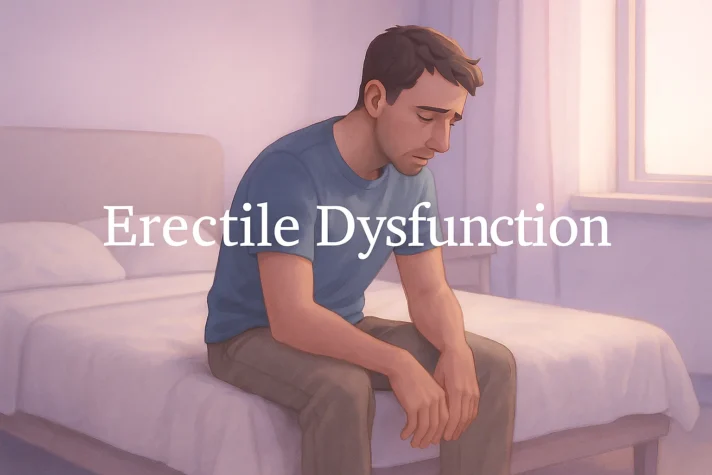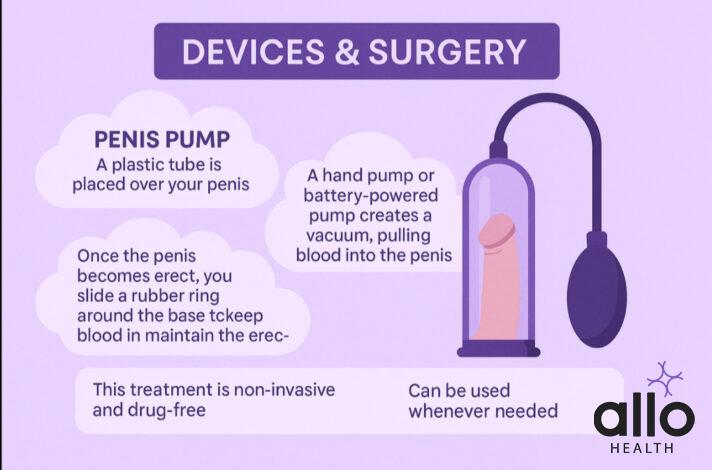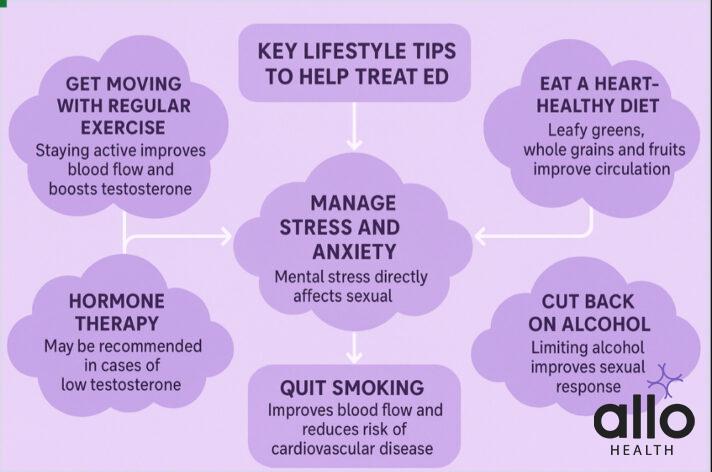What is Erectile Dysfunction? Causes, Symptoms, Diagnosis & Treatment

Erectile dysfunction (ED) is when you can’t get or keep an erection firm enough for sex. It can stem from physical, psychological, or lifestyle-related factors, like poor blood flow, stress, or low testosterone. Diagnosis involves physical exams, lab tests, and sometimes imaging. Fortunately, ED is treatable with medications, devices, therapy, or lifestyle changes. The key is to identify the root cause and seek help early.
Erectile dysfunction (ED) affects millions of men worldwide, yet many suffer in silence. If you’re searching for what erectile dysfunction is or wondering about its causes, you’re not alone. This condition, also known as men impotence, can happen to anyone regardless of age.
Our guide breaks down erectile dysfunction in simple terms. We’ll explore normal erection function, common causes of ED, and proven treatment options. Whether it’s physical issues like poor blood flow or mental health concerns, most cases can be managed with proper care.
Don’t let erectile dysfunction control your life. With the right information and support, you can take steps toward better sexual health and confidence.
Understanding Erectile Dysfunction
Erectile dysfunction (ED) is the difficulty or inability to achieve or maintain a penile erection firm enough for sexual activity. This condition affects men of all ages and is more common than most people realize.
During normal arousal, your brain sends signals that release a chemical called nitric oxide. This helps the muscles in the penis relax, so blood can flow in and make it firm, which is what creates an erection.
What is a Normal Erection?
Before discussing erectile dysfunction, let’s understand how erections work naturally.
The penis contains small compartments throughout its length. An erection happens when these compartments fill with blood, making the penis firm. This process typically starts with sexual arousal through touch, thoughts, or feelings.
The Biological Process Step by Step:
- The brain gets excited and sends signals to the penis
- Nitric oxide is released during arousal, relaxing the penile muscles
- Blood vessels open up and allow increased blood flow
- Penis compartments fill with blood and become hard
- Veins that drain blood remain closed, maintaining firmness
- After arousal ends, blood flows out, and the penis softens
A normal erection means your blood flow, hormones, and nerves work well together. Erections can occur during sexual activity, while thinking about sex, or even during sleep
Causes of Erectile Dysfunction
These are the causes of erectile dysfunction.
Causes of erectile dysfunction
Biological and Structural Causes of Erectile Dysfunction:
1. Poor blood flow
- Poor blood flow makes it harder for enough blood to reach the penis, which is essential for getting and maintaining an erection.
- Conditions like heart disease or cardiovascular disease, high blood pressure, atherosclerosis (accumulation of cholesterol), or coronary artery disease can narrow or damage blood vessels, reducing circulation.
- Vascular risk factors like diabetes, smoking, and high cholesterol can damage blood vessels, affecting erection quality.
- In many cases, erectile dysfunction can even be an early sign of heart-related issues (cardiovascular disease or vascular disease)
2. Cavernosal Disorders (A condition affecting the corpora cavernosa)
- The corpus cavernosum [1], two sponge-like chambers in the penis, plays a key role in erection.
- Disorders here can severely affect function as the two sponge-like regions of the erectile tissues in the penis fill up with blood during an erection.
- Peyronie’s disease involves fibrous tissue in the penis. Peyronie’s Disease is a condition in which fibrous scar tissue forms in the deeper tissues under the skin of the penis. This causes curved, painful erections.
- Anything that affects penile tumescence (the hardening of the penis) can contribute to erectile dysfunction.
3. Diabetes
Diabetes[2] can damage both nerves and blood vessels over time, making it harder for signals to reach the penis and for enough blood to flow in for a firm erection.
4. Hormonal imbalances (low testosterone)
Low testosterone [3] can make it harder to feel interested in sex and may cause problems like trouble getting or keeping an erection. It can also lead to low energy, mood changes, and less satisfying sexual experiences overall.
Patient Voice: “I never thought my sugar levels could be causing ED until I got my HbA1c checked. Turns out it was 9.2. Once I started managing my diabetes properly, my erections improved within 3 months.”
Doctors may use a penile Doppler ultrasound [4] to check blood flow in the penis. This is a widely used diagnostic test to examine and measure the blood flow into your penis, which could be causing erectile dysfunction (ED).
Psychological Causes of Erectile Dysfunction
1. Depression, stress, and anxiety leading to ED
Mental health issues like stress, anxiety, or depression can make it hard for the brain to send the right signals needed for an erection. These problems can also lower your sex drive and confidence, making erectile dysfunction worse over time.
2. Performance anxiety, low self-esteem leading to ED
When you doubt yourself or worry about your sexual performance, it can create mental pressure that makes it hard to get aroused. This stress can distract your mind and body, making it difficult to relax and enjoy the moment.
Behavioral Causes of Erectile Dysfunction
1. Alcohol
Drinking too much alcohol can reduce blood flow to the penis, making it harder to get or keep an erection. It can also lower sexual desire.
2. Drugs
Recreational drugs interfere with brain signals and blood flow, affecting your ability to perform sexually and enjoy intimacy.
3. Smoking
Smoking damages blood vessels and lowers blood circulation, which is key to achieving an erection. It also affects hormone levels over time.
4. Exercise
A sedentary lifestyle reduces blood flow and energy levels, making erections weaker and the sex drive lower.
5. Poor Diet
Unhealthy food habits can lead to weight gain, poor circulation, and hormonal imbalance, especially low testosterone, all of which harm sexual desire (libido).
Internal Data from Allo Health:
According to Allo Health’s clinical data from over 2.5 lakh men treated, 62% of men under the age of 35 with erectile dysfunction were found to have anxiety-related symptoms as the primary cause.
Erectile Dysfunction Symptoms
Symptoms of ED involve trouble getting or keeping an erection firm enough for sexual activity. This doesn’t mean a complete loss of interest in sex, but rather your body not responding as desired.
Common Signs Include:
Intermittent Erections
You can sometimes get an erection, but not consistently when wanted. For example, morning erections might occur, but not with your partner.
Difficulty Maintaining Erections
You achieve an erection initially, but it doesn’t last long enough. The erection fades before or during sexual activity.
Complete Inability to Get Erections
Despite feeling aroused, your body doesn’t respond at all. No erection occurs even with adequate stimulation.
Healthcare providers may use the International Index of Erectile Function Questionnaire to evaluate symptom severity and nature.
Diagnosis of Erectile Dysfunction
Step 1: Talking to Your Healthcare Provider
To determine the cause of ED, your healthcare professional will begin by asking questions and conducting a physical examination. These questions may feel private or uncomfortable, but being honest is very important. It helps your provider understand what’s going on and how to help you best.
What Questions Will They Ask?
About Your Health
- Are you taking any prescription drugs or supplements [5]?
- Do you use nonmedical drugs?
- Do you smoke or drink alcohol? If yes, how much?
- Have you had any surgery or radiation in the pelvic area?
- Do you have any urinary or other health problems?
- Have you ever been diagnosed with anxiety or depression?
- Do you have any heart-related problems?
About Your Erectile Dysfunction Symptoms
- When did the symptoms start? Did they happen slowly or suddenly?
- Do you get erections in the morning or during sleep?
- How firm are your erections? Is penetration difficult?
- Do your erections change in different situations (like with a partner, during oral sex, or masturbation)?
- Do you have issues with sex drive, ejaculation, or orgasm?
- Is sex painful, or do you feel any lumps or curvature in the penis?
About Your Emotional Health and Relationships
- Are you under a lot of stress?
- Do you have any mental health concerns like anxiety or depression?
- Are you satisfied with your sex life or relationship?
- Have there been any recent changes in your relationship?
Step 2: Physical Exam
The doctor may:
- Check your penis and testicles
- Check your heart, blood pressure, and circulation
- Possibly do a rectal exam [6] (depending on your age and health history) to check your prostate
Step 3: Lab Tests
To look for possible causes of ED, your provider may order:
- Blood tests [7] (to check hormones like testosterone, blood sugar for diabetes, cholesterol, liver and kidney function, and more)
- Urine test (urinalysis)[8]
Your provider may order lab and other tests to evaluate hormones, blood sugar, and organ function.
Step 4: Special Tests (if needed)
If more information is needed, your provider might recommend:
Penile Doppler ultrasound
A penile duplex Doppler ultrasound can visualize blood flow and detect vascular (blood vessel) abnormalities more accurately. Checking blood flow in the penis.[4]
Nocturnal penile tumescence (NPT)
A test to see if you get erections during sleep.[9]
Penile biothesiometry
This test assesses how well the penile nerve endings respond to vibration and stimuli.[10]
Vasoactive injection
A shot into the penis to see if it becomes erect. [11]
MRI or CT scan
Usually only done if there are trauma or cancer concerns.[12]
If standard treatments don’t work, your doctor might discuss enrolling in clinical trials exploring new ED therapies.
Real Life Example from Allo Health:
A 32-year-old male with newly diagnosed diabetes and ED came to our clinic. He showed a 60% improvement in erection quality after switching to a low-carb diet, treating insulin resistance, and being regular at therapy sessions.
Treatment Options for Erectile Dysfunction
Oral Medicines
Medicines like Viagra / Oral PDE-5 inhibitors or phosphodiesterase type 5 inhibitors (sildenafil), Cialis (tadalafil), Vardenafil, and Stendra (avanafil) help increase blood flow to the penis during sexual arousal. Since the penis consists of small compartments, these medications help in relaxing the blood vessels. These drugs work through phosphodiesterase (an enzyme) inhibition, which increases blood flow. This leads to the filling of all the empty compartments of the penis without any issues.
They don’t cause automatic erections; you still need sexual stimulation.
Side effects may include headaches, flushing, or an upset stomach.
Not safe for men taking nitrates or with certain heart problems.
1. Self-injection
A tiny needle injects medicine directly into the penis to create an erection. Drugs like prostaglandin E1 are commonly used in intracavernosal injections (medicine is directly injected into the erectile tissue) to directly stimulate an erection. [13]
2. Intraurethral medicine
A small applicator places medicine into the tip of the penis.
3. Testosterone therapy
- For men with low testosterone levels, sometimes combined with other treatments.
- Useful for men who can’t take erectile dysfunction medication.
Devices & Surgery
Penis Pump, also called a vacuum erection device or vacuum pump, is a non-surgical device that helps you get and keep an erection. Also known as a vacuum constrictive device, the penis pump helps draw blood into the penis using negative pressure.
- A plastic tube is placed over your penis.
- A hand pump or battery-powered pump creates a vacuum, pulling blood into the penis.
- Once the penis becomes erect, you slide a rubber ring around the base to keep the blood in and maintain the erection.
- The pump is then removed, and the ring is taken off after sex.
- This treatment is non-invasive and drug-free
- Can be used whenever needed
Some men benefit from penile rehabilitation, a structured approach to regain sexual function after prostate surgery or other procedures.

Penile Implants
Penile implants are a surgical option for men who haven’t had success with other erectile dysfunction treatments.
There are two main types of penile prostheses
- The semi-rigid rods
- The inflatable penile prosthesis
Penile implants (also called penile prostheses) include inflatable penile prostheses or semi‑rigid rods. These penile implants have fluid-filled cylinders that can be pumped to create an erection and deflated afterward. You control when and how long the erection lasts.
- These are reliable, long-term solutions.
- There is a high satisfaction rate among men and their partners
Counseling for Erectile Dysfunction
If stress, anxiety, depression, or relationship problems are affecting your ability to get or keep an erection, counseling can be a helpful part of treatment.
Individual therapy
A therapist can help you manage stress, anxiety, or past experiences that may be affecting your sexual confidence.[14]
Couples counseling
If ED is causing problems in your relationship, or if relationship issues are contributing to the problem. Talking with a counselor together can improve communication, reduce pressure, and rebuild intimacy smoothly.[15]
Sex therapy
Sex therapy is when a trained sex therapist can guide you through exercises and strategies to reduce performance anxiety and improve sexual satisfaction.

Lifestyle Changes to Treat Erectile Dysfunction
Making small but consistent changes to your daily habits can have a big impact on your sexual health. Here are some key lifestyle tips that can help treat erectile dysfunction (ED):
Get Moving with Regular Exercise
Staying active and following an exercise routine improves blood flow throughout your body, including to the penis. It also helps boost testosterone levels, reduce stress, and support heart health, all of which are important for firm erections.
Low testosterone
Hormone therapy may be recommended under medical supervision. This may involve testosterone supplementation, especially if levels are below normal and contribute to ED.
Eat a Heart-Healthy Diet
A balanced diet rich in leafy greens, whole grains, fruits, vegetables, and omega-3 fats can improve blood circulation, maintain better cardiovascular health, and keep your hormones in check. What’s good for your heart is good for your erection.
Quit Smoking
Smoking damages blood vessels and limits blood flow to the penis, which makes it harder to get or keep an erection. Silent smoking also leads to cardiovascular disease. Quitting may feel tough, but it’s one of the most powerful steps you can take to improve your sexual health and your heart health (cardiovascular health).
Cut back on alcohol
Drinking too much can reduce sexual sensitivity and affect your ability to maintain an erection. Limiting alcohol helps improve blood flow and sexual response.
Manage Stress and Anxiety
Mental stress can directly affect your ability to perform sexually. Try relaxation techniques like deep breathing, meditation, yoga, or talking to a therapist. If ED is affecting your relationship, couples counseling can help rebuild trust and closeness.
Men often hesitate to bring up ED, but you’re not alone. Once we understand the cause, treatment can be surprisingly effective.”
Erectile Dysfunction is common but treatable
Many men feel worried when they experience erectile dysfunction, but it’s important to know that erectile dysfunction is very common, especially as men get older. Occasional difficulty with erections can happen to anyone and doesn’t always mean there’s a serious problem. Understanding that erectile dysfunction is a common issue can help reduce anxiety and make it easier to seek help if needed.
According to the National Institute of Diabetes and Digestive and Kidney Diseases, ED is common and treatable with medical or lifestyle approaches.
"The following blog article provides general information and insights on various topics. However, it is important to note that the information presented is not intended as professional advice in any specific field or area. The content of this blog is for general educational and informational purposes only.
Book consultation
The content should not be interpreted as endorsement, recommendation, or guarantee of any product, service, or information mentioned. Readers are solely responsible for the decisions and actions they take based on the information provided in this blog. It is essential to exercise individual judgment, critical thinking, and personal responsibility when applying or implementing any information or suggestions discussed in the blog."






